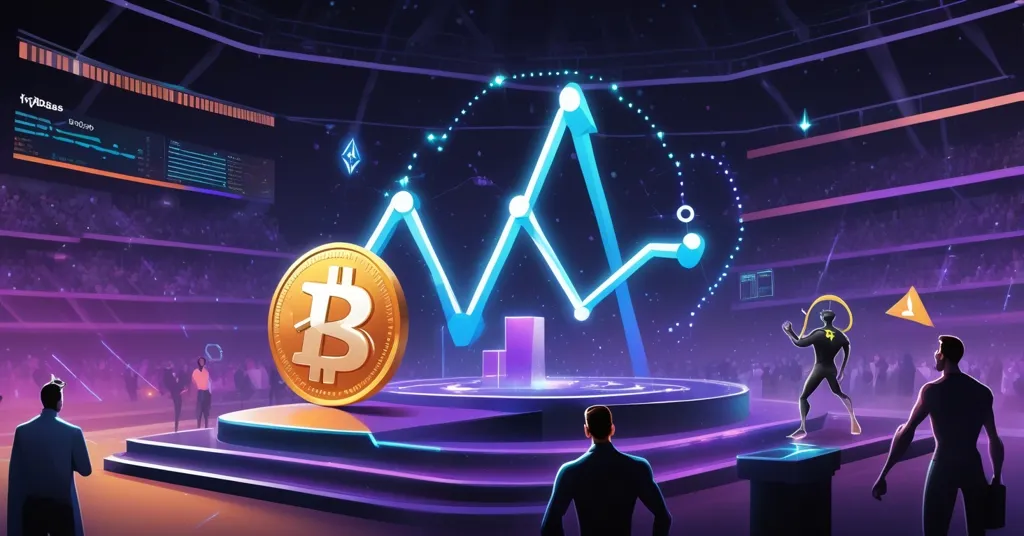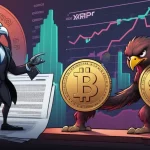XRP Overtakes Ethereum on Coinbase in 2025: Real Rally or Speculative Hype?

XRP Surpasses ETH on Coinbase in 2025: Rally or Just Another Mirage?
XRP has staged a stunning comeback, overtaking Ethereum (ETH) in trading volume on Coinbase for the first half of 2025, a move that’s got the crypto world buzzing. After years of regulatory hell, is this the moment Ripple’s embattled token finally breaks free, or are we just witnessing another speculative fever dream in a market notorious for hype?
- Volume Victory: XRP claimed 16% of Coinbase’s transaction revenue through June 2025, narrowly beating ETH’s 15%.
- Regulatory Redemption: A 2023 court ruling deemed XRP not a security on exchanges, sparking its relisting and trader frenzy.
- Price Pushback: Despite the buzz, XRP struggles with technical resistance at $3.10 and bearish market signals.
XRP’s Coinbase Comeback: From Pariah to Powerhouse
Let’s dive into the hard numbers driving this story. According to Coinbase’s SEC 10-Q filing dated July 31, 2025, XRP accounted for 16% of the exchange’s transaction revenue in the first half of the year, edging out Ethereum’s 15%. Drilling down to Q2 alone, XRP grabbed a 13% share compared to ETH’s 12%. That’s a jaw-dropping reversal from last year when XRP didn’t even register in Coinbase’s breakdowns, buried under the weight of legal battles. Ryan Rasmussen, Head of Research at Bitwise, captured the shock perfectly:
Wow, XRP trading accounted for more of Coinbase’s trading revenue this year than ETH. Last year XRP wasn’t even broken out.
For those unfamiliar with the drama, here’s the quick and dirty. Back in 2020, the U.S. Securities and Exchange Commission (SEC) hit Ripple Labs—XRP’s creator—with a lawsuit, claiming the token was an unregistered security. Being tagged as a security means facing tighter rules and oversight, often spooking investors and choking a token’s market reach. The fallout was brutal: Coinbase delisted XRP in 2021, sending it into a tailspin of obscurity. Then came the lifeline in 2023—a federal court ruled that XRP isn’t a security when traded on secondary markets like exchanges. While Ripple still faces heat over direct sales, this partial win was enough for Coinbase to bring XRP back into the fold, and traders have responded in droves. Suddenly, a token many wrote off as dead is outmuscling Ethereum, the heavyweight of decentralized finance (DeFi), on one of America’s biggest crypto platforms. For deeper insights into what fuels this surge, check out this analysis of XRP’s trading volume on Coinbase.
Derivatives Push: Coinbase Bets Big on XRP
Coinbase isn’t just sitting back and watching the XRP wave—they’re surfing it with gusto. Through Coinbase Derivatives, they’ve become the first U.S.-regulated exchange to offer 24/7 futures trading for a handful of top assets: Bitcoin (BTC), Ethereum, Solana (SOL), and, notably, XRP. This round-the-clock access is already paying off, with weekend trading volumes inching closer to weekday levels. On August 18, 2025, Coinbase Institutional will up the ante further by launching nano Ripple perpetual futures, a leveraged product tailored for U.S. traders hungry for more XRP action. For the uninitiated, perpetual futures are contracts that never expire, letting traders bet on price swings with amplified gains—or losses—without owning the actual token. Think of it as playing high-stakes poker with borrowed chips. More details on this development can be found in this update on Coinbase’s XRP futures launch.
Why does this matter? Globally, 75% of crypto trading volume comes from derivatives, but the U.S. market has lagged behind, shackled by regulatory hurdles. Coinbase’s aggressive move here isn’t just about XRP—it’s about capturing a massive slice of that derivatives pie and deepening liquidity. For U.S. traders, both retail and institutional, this opens doors to tools that were once offshore exclusives. It’s a step toward effective accelerationism, the kind of rapid, permissionless innovation we champion, pushing crypto into mainstream finance whether regulators like it or not. But let’s not get too starry-eyed—more leverage also means more risk, and in a volatile market, that’s a double-edged sword. For a broader perspective on this shift, take a look at this discussion on XRP derivatives trading impact.
XRP Price Analysis: Hype Meets Hard Reality
Before anyone starts dreaming of XRP rocketing skyward, let’s ground ourselves with the charts. Despite the trading volume surge on Coinbase, XRP’s price is stuck in a rut. It’s grappling with a stubborn resistance level at $3.10, right alongside the 50-period Simple Moving Average (SMA) at $3.1177. Resistance, for those new to the game, is a price point where selling pressure often smothers buying interest, blocking upward momentum. If it falls, support levels—where buyers might jump in—sit at $2.8937, $2.7839, and $2.6655. Then there’s the Relative Strength Index (RSI), a gauge of market momentum, sitting at a dreary 37.37. Think of RSI as a thermometer for a token’s health: below 40 often signals bearish vibes, like an engine running too cold to hit top speed. Add a descending trendline and wishy-washy candlestick patterns, and the market looks more bored than bullish. For a detailed breakdown, see this XRP market and resistance analysis for 2025.
High trading volume doesn’t always translate to genuine adoption—sometimes it’s just speculators chasing the next quick flip or pump-and-dump scheme. XRP’s fundamentals, like its use case for cross-border payments, are solid on paper, but they’re not enough to overpower technical barriers yet. Compare this to Ethereum, where trading volume may have dipped on Coinbase, but its sprawling DeFi ecosystem and smart contract dominance give it a deeper moat. XRP’s current edge might be more about short-term sentiment than long-term value, a reminder that crypto markets rarely play by logical rules. Curious about what drives these volume trends? This exploration of XRP’s volume over Ethereum offers some thought-provoking angles.
Broader Market Headwinds: Not Just an XRP Problem
XRP’s technical woes aren’t happening in isolation. On July 31, 2025, the broader crypto market took a 5.4% nosedive, rattled by uncertainty over U.S. Federal Reserve interest rate moves. When macro winds howl, they don’t discriminate—Bitcoin, Ethereum, and XRP all feel the sting. Rising rates often pull capital away from risky assets like crypto, and with global economic jitters in play, even the hottest trading stats can’t shield a token from the storm. XRP’s path to a sustained surge looks less like a clear runway and more like a gauntlet of potholes, with external forces ready to derail any momentum.
A Side Note on Innovation: Bitcoin Hyper’s Bold Play
While XRP leans on regulatory wins for its revival, other corners of the crypto space are pushing forward with raw innovation. Enter Bitcoin Hyper ($HYPER), a Bitcoin-native Layer 2 solution built on the Solana Virtual Machine (SVM). This project has pulled in over $6.2 million in its public presale, aiming for a $21.6 million target with tokens priced at $0.0115. Its pitch? Merge Bitcoin’s battle-tested security with Solana’s blistering transaction speeds to power smart contracts, decentralized apps (dApps), and even meme coin creation. Audited by Consult for scalability and trust, it’s positioning itself as a serious player for 2025. For community reactions and credibility checks, dive into this Reddit discussion on Bitcoin Hyper’s presale.
From a Bitcoin maximalist perspective, this kind of project gets a cautious thumbs-up. Extending BTC’s utility without tampering with its core ethos of decentralization is the effective accelerationism we root for—driving progress without begging for permission. But let’s not ignore the red flags. Solana’s history of network outages raises questions about whether it can truly carry Bitcoin’s weight. Plus, Layer 2 solutions often face adoption hurdles—will developers and users actually flock to this hybrid, or will it fizzle amid competition? Still, while XRP fights legal and technical battles, projects like Bitcoin Hyper remind us that crypto’s future often hinges on bold tech leaps, not just courtroom dramas.
The Centralization Shadow: XRP’s Achilles’ Heel
Let’s address the elephant in the room: XRP’s centralized baggage. As much as we cheer for disrupting the status quo and championing financial freedom, XRP’s deep ties to Ripple Labs remain a glaring flaw. Unlike Bitcoin, which thrives on a leaderless, trustless network where no single entity calls the shots, XRP’s fate is often tethered to Ripple’s corporate moves and legal quagmires. Ripple controls a hefty chunk of XRP’s supply through escrow releases, a setup that’s worlds apart from Bitcoin’s fixed issuance or even Ethereum’s community-driven governance. The 2023 ruling was a middle finger to the SEC’s overreach, no doubt, but it’s not a free pass for trust. XRP’s corporate shadow looms large, a stark reminder that not all crypto is equal in the fight for true sovereignty. For a comprehensive overview of XRP and its background, refer to this detailed resource on XRP.
Altcoins like XRP and platforms like Ethereum do fill niches Bitcoin doesn’t tackle directly—think lightning-fast transactions for payments or complex smart contracts for DeFi. We’re not blind to their roles in this financial revolution. But let’s keep perspective: Bitcoin remains the gold standard for privacy and resilience, a hedge against fiat decay and centralized overreach. XRP’s volume spike on Coinbase is flashy, sure, but it doesn’t dethrone BTC as the ultimate tool for personal empowerment. No trading stat can rewrite that truth.
Speculative Noise: Cutting Through the Garbage
So, could XRP’s moment on Coinbase ignite a broader rally? It’s possible, but don’t mortgage your house on it. The derivatives push and trading numbers are eye-catching, yet technical resistance and macro uncertainty cast long shadows. And let’s be brutally honest—most XRP price prophecies circulating online are pure snake oil, about as reliable as a carnival fortune teller. Beware the YouTube grifters swearing XRP will hit $100 by New Year’s—they’re more likely to sell you a bridge than a winning trade. We’re not here to peddle fantasies or shill tokens; our job is to slice through the nonsense and lay out the facts. XRP’s tale is one of grit and redemption, no question, but it’s also a harsh lesson that regulatory wins are fragile, and market realities bite even harder. Community opinions on this topic are lively, as seen in this Reddit thread discussing XRP overtaking Ethereum.
What’s Next for XRP and Beyond?
XRP’s climb on Coinbase marks a fascinating chapter in crypto’s wild saga, blending legal victories with raw market grit. Looking ahead, a few catalysts could shape its trajectory—further regulatory clarity, adoption by financial institutions for cross-border payments, or a shift in broader market sentiment if macro conditions ease. But risks abound, from Ripple’s ongoing legal skirmishes to the ever-present threat of speculative bubbles. As we push for decentralization and financial liberty, we must stay razor-sharp on the flaws and pitfalls. Bitcoin still wears the crown for pure disruption, but players like XRP and innovators like Bitcoin Hyper show us this revolution is a chaotic, multi-front war. Keep your wits about you—the battle is far from won. For speculative takes on XRP’s potential rally, explore this prediction on XRP’s price trajectory.
Key Questions on XRP’s 2025 Momentum
- What’s driving XRP to surpass Ethereum on Coinbase in 2025?
XRP’s lead, with 16% of Coinbase’s transaction revenue versus ETH’s 15% in early 2025, stems from a 2023 court ruling that it’s not a security on exchanges, spurring its relisting and fueling trader interest, though it’s no guarantee of outshining Ethereum’s DeFi stronghold long-term. - How does Coinbase’s XRP derivatives launch impact U.S. crypto trading?
With 24/7 futures and nano Ripple perpetual futures rolling out in 2025, Coinbase gives U.S. traders leveraged ways to bet on XRP, boosting liquidity and drawing institutional eyes in a market once starved for such tools due to regulatory constraints. - Why isn’t XRP’s price soaring despite strong trading volume?
Even with Coinbase’s numbers, XRP hits resistance at $3.10 and a bearish RSI of 37.37, showing weak momentum. Macro uncertainty, like U.S. Fed rate fears, adds pressure, proving volume doesn’t always equal price gains. - What’s Bitcoin Hyper’s role in crypto innovation?
Bitcoin Hyper, a Layer 2 blending Bitcoin’s security with Solana’s speed, raised $6.2 million in presale by 2025 for dApps and smart contracts. It embodies effective accelerationism, though Solana’s past outages raise doubts about reliability. - Could XRP’s rise trigger a wider altcoin surge this year?
It’s plausible if regulatory wins build broader confidence, but XRP’s centralized roots and technical hurdles urge caution. Ignore baseless price predictions—real rallies need more than hype to beat market and macro challenges.



